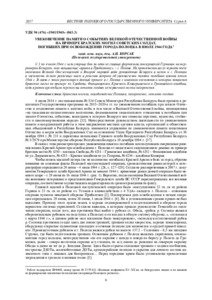Please use this identifier to cite or link to this item:
https://elib.psu.by/handle/123456789/20752Full metadata record
| DC Field | Value | Language |
|---|---|---|
| dc.contributor.author | Корсак, А. И. | - |
| dc.date.accessioned | 2017-11-13T08:14:08Z | - |
| dc.date.available | 2017-11-13T08:14:08Z | - |
| dc.date.issued | 2017 | - |
| dc.identifier.citation | Вестник Полоцкого государственного университета. Серия A, Гуманитарные науки. - 2017. - № 9 – C. 6-14. | ru_RU |
| dc.identifier.issn | 2070-1608 | - |
| dc.identifier.uri | https://elib.psu.by/handle/123456789/20752 | - |
| dc.description | Perpetuating of Memory of the Great Patriotic War Events on the Example of Mass Graves of the Soviet Soldiers Who Have Died At Release of Polotsk in July 1944 A. Korsak | ru_RU |
| dc.description.abstract | С 1 по 4 июля 1944 г. шли упорные бои за один из главных форпостов гитлеровской Германии на территории Беларуси, так называемые «врата в Прибалтику», – г. Полоцк. На протяжении всего периода после окончания Великой Отечественной и Второй мировой войн руководство Беларуси в целом и г. Полоцка в частности делало различные шаги в решении вопроса об увековечении памяти погибших воинов летом 1944 г. В связи с этим рассмотрен данный процесс в г. Полоцк с анализом состояния и истории появления братских могил на примере пл. Свободы, Фатыновского, Красного, Ксаверьевского и Громовского кладбищ, куда в разное время были перенесены останки солдат из первичного места захоронения.= From July 1 to July 4, 1944 persistent fights for one of the main outposts of Hitlerite Germany in the territory of Belarus, a so-called "gate to the Baltics", – Polotsk were going. Throughout the entire period after the termination of the Great Patriotic War and World War II of wars the leadership of Belarus in general and Polotsk in particular took various steps in the solution of a question of perpetuating of memory of the died soldiers in the summer of 1944. In this regard in article this process to Polotsk with the analysis of a state and history of emergence of mass graves on the example of Svoboda Square, Fatynovsky, Red, Ksaveryevsky and Gromovsky cemeteries where remains of soldiers from primary place of burial have been at different times transferred is considered. | ru_RU |
| dc.language.iso | ru | ru_RU |
| dc.publisher | Полоцкий государственный университет | ru_RU |
| dc.relation.ispartof | Веснік Полацкага дзяржаўнага ўніверсітэта. Серыя А, Гуманітарныя навук | be_BE |
| dc.relation.ispartof | Herald of Polotsk State University Series A, Humanity sciences | en_EN |
| dc.relation.ispartof | Вестник Полоцкого государственного университета. Серия A, Гуманитарные науки | ru_RU |
| dc.relation.ispartofseries | Серия A, Гуманитарные науки;2017. - № 9 | - |
| dc.rights | open access | ru_RU |
| dc.subject | Государственный рубрикатор НТИ - ВИНИТИ::ОБЩЕСТВЕННЫЕ НАУКИ::История. Исторические науки | ru_RU |
| dc.subject | Братская могила | ru_RU |
| dc.subject | Освобождение Полоцка | ru_RU |
| dc.subject | Захоронение | ru_RU |
| dc.subject | Останки солдат | ru_RU |
| dc.subject | Mass grave | ru_RU |
| dc.subject | Liberation of Polotsk | ru_RU |
| dc.subject | Burial | ru_RU |
| dc.subject | Remains of soldiers | ru_RU |
| dc.title | Увековечение памяти о событиях Великой Отечественной войны на примере братских могил советских солдат, погибших при освобождении города Полоцка в июле 1944 года | ru_RU |
| dc.type | Article | ru_RU |
| dc.identifier.udc | 94 (476) «1941/1945» (043.3) | - |
| Appears in Collections: | 2017, № 9 | |
Items in DSpace are protected by copyright, with all rights reserved, unless otherwise indicated.
